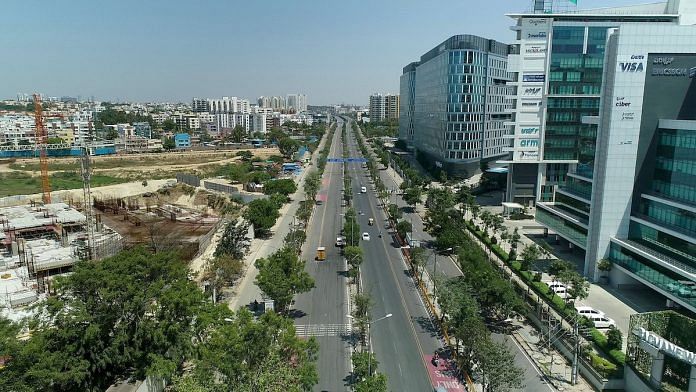New Delhi: Millions of Indians were pushed into poverty during the Covid-19 pandemic, but the period post the initial strict lockdown also saw a decline in income inequality in the country, a working paper published last month has said.
The paper, titled ‘Inequality in India declined during Covid’, published by the National Bureau of Economic Research (NBER), a US-based non-profit that focuses on conducting and disseminating research on economics, said the pandemic in India was associated with a decline in inequality in two senses. The first was that Indians from higher income groups had larger relative reductions in income than the poor, and the second was that consumption inequality also declined, albeit only marginally so.
The non-peer reviewed study was led by three scholars — Arpit Gupta from the Stern School of Business, University of New York, and Anup Malani and Bartosz Woda from the University of Chicago Law School.
The researchers’ main source of data was the Consumer Pyramids Household Survey (CPHS), conducted by the Centre for Monitoring Indian Economy, which comprises a sample of 1.97 lakh households, with monthly information on their finances available from January 2015 to July 2021.
The study’s most remarkable finding — that income inequalities have declined in the months since the lockdown was lifted — seem to stand in contrast with what other recent studies have said about income inequalities in India.
According to the World Inequality Report 2022, the top 10 per cent of Indians had about 96 times more income on average than the bottom 50 per cent. Similarly, Oxfam International claimed that in 2021 India’s top 1 per cent owned about 77 per cent of the country’s wealth.
The NBER paper, however, qualifies its findings by noting that Gini coefficients — a statistical measure of the amount of inequality that exists in a population — “paint a less rosy picture of inequality” during the pandemic, specifically a “return to pre-pandemic levels of inequality by July 2020”.
Secondly, the decline in inequality actually began in 2018, a trend that was “interrupted” by the lockdown, but which then resumed.
Also Read: Rich getting richer, poor getting poorer — answer to India’s V vs K economic recovery question
How did the gap shorten?
Income inequality is basically the average gap between the incomes of the rich and the poor. This ‘inequality’ falls if the incomes of the rich fall, or if the incomes of the poor rise.
The study shows that the reduction in income inequality in India could be attributed to incomes of upper-income households falling during the pandemic.
The authors acknowledged that there was a “stark increase in poverty” during the pandemic, but also pointed out that “increases in poverty are not a sufficient statistic for inequality”.
According to the study, income poverty in urban areas jumped from 40 per cent before the pandemic to nearly 70 per cent during the lockdowns. Poverty was defined, in this case, by the World Bank’s $1.9 a day (or less) benchmark. After the lockdown, poverty fell and income and consumption increased, “but it did not recover to pre-pandemic levels”, the researchers said.
However, despite the increase in poverty, income inequality fell in both urban and rural areas, largely because the earnings of richer households went down.
“In rural areas, the relative income of individuals from top-quartile households fell more before, fell further during, and remained more depressed after the lockdown compared to incomes of those from lower quartiles. Urban areas show a similar pattern, except that the dip during the lockdown was identical across quartiles,” the study said.
Similarly, the study shows that consumption inequality also decreased during the lockdown period, but not as fast as income inequality.
Before the pandemic, a 10 per cent fall in income would result in a 0.98 per cent decline in consumption expenditure, which means for every Rs 100 reduction in income, a person would cut consumption by Rs 9.8. During the pandemic, the authors found that a 10 per cent reduction in income would result in a fall in consumption of 0.869 per cent, or that for every Rs 100 reduction a person would reduce their consumption by Rs 8.6 — a very small difference.
The authors attributed this largely to “consumption smoothing”, which refers to the tendency to adjust spending and saving habits by maintaining stable consumption habits.
Why did incomes of richer people fall?
According to the study, the sources of income of India’s rich derive “disproportionately” from services and capital income (basically wealth derived from wealth, like dividends and interest), both of which were “disproportionately impacted during the pandemic”. Unlike for the rich, capital incomes do not form a major share in the incomes of poorer households.
The authors further noted that labour demand was a factor. “A larger fraction of top-quartile income is from the service sector… and that sector experienced the largest drop in consumer expenditure during the pandemic,” the study said.
Demand for the type of labour supplied by the rich also dropped more than for the poor. “The rich experienced larger declines in wages and, after India’s lockdown, lower employment rates,” the study added.
The employment rate fell more for the poorer sections of society during the lockdown, but they also recovered more quickly. In fact, employment rate “recovered almost completely for all quartiles — except the top quartile — after the lockdown,” the study said.
It added that the performance of the lower percentiles was “particularly remarkable” since India, unlike the US, had “little fiscal stimulus in the form of income transfers”.
(Edited by Asavari Singh)
Also Read: Modi govt’s pandemic strategy focused on revival has worked. Economic indicators prove it






